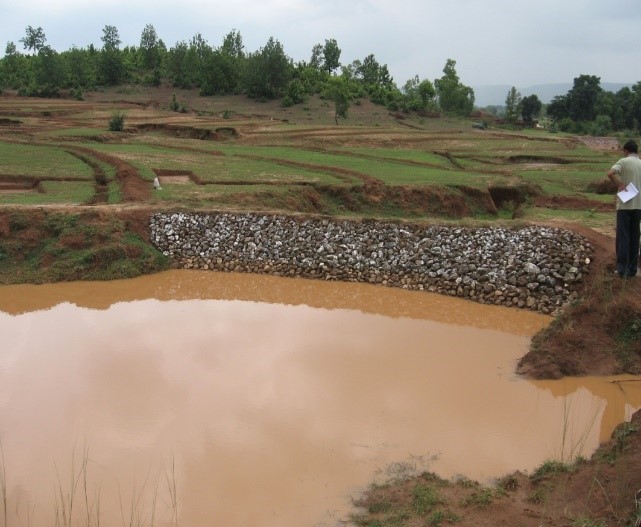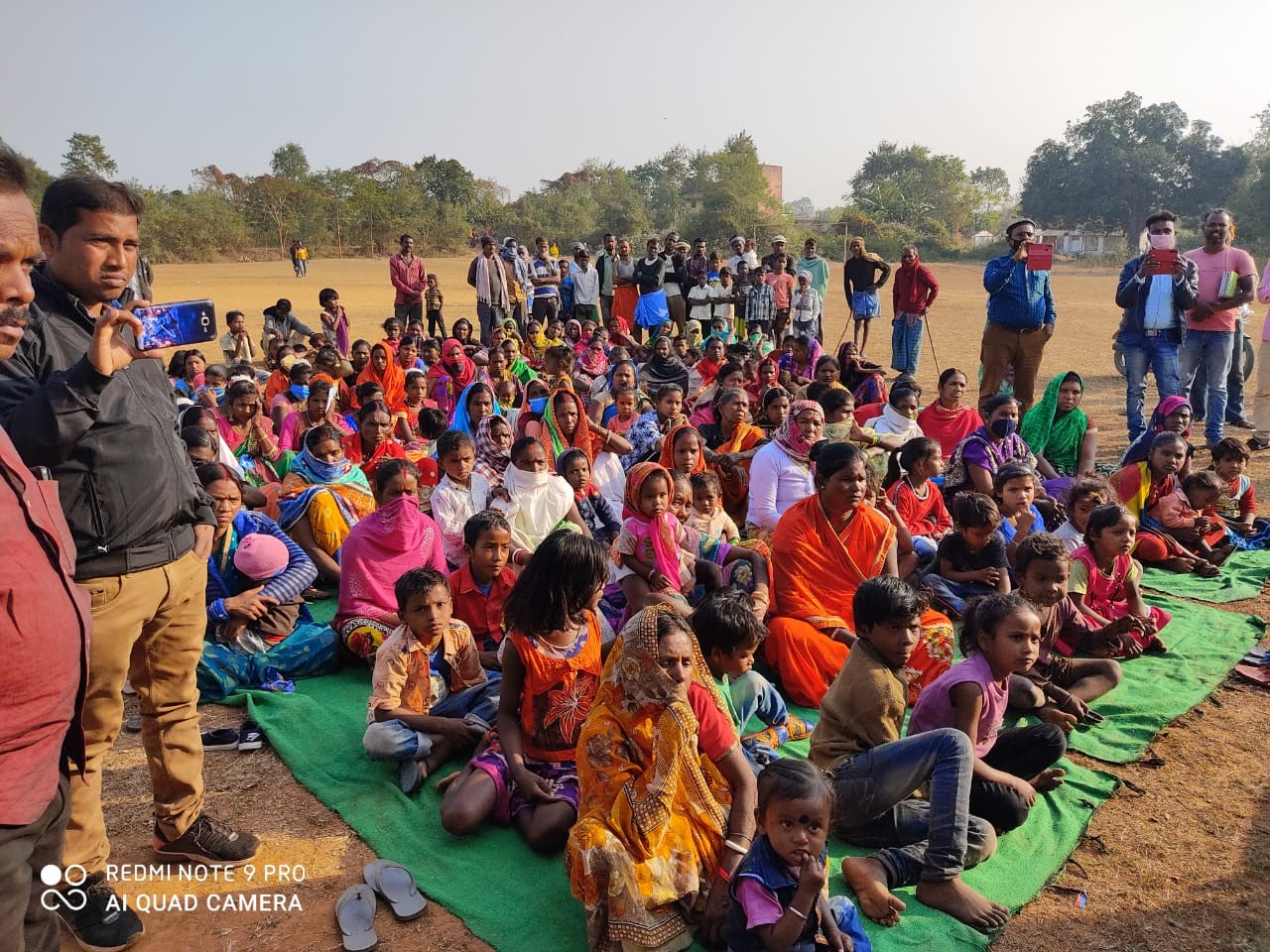Irrigated agriculture in India has likely to be reached its limit and further sustainable increases in food production must come from dryland farming by proper watershed development and its management. Since, main stay for the 75% of rural population of the country depends on agriculture to their primary mean of livelihood and India is ranked first in Rainfed Agriculture globally, in area (86 million ha) as well as value of produce. So, approach of watersheds including mechanical measures such as terracing, bunding, Contour Trench, Rainwater Harvesting etc. are used to minimize runoff & soil erosion for rainfed farming that leads livelihood enhancement and livestock development for tribal communities and contribute to the successful functioning of the ecosystem.
In rainfed agriculture dominant area of India where two-thirds of the cropped area is dependent on rainfall without any protective irrigation facilities. These regions have long been also the victims of neglect on the policy front. Rainfed areas characterized by low levels of productivity and low input usage. Development in rainfed areas has been receiving considerable priority through several initiations in recent past. In the context of integration of pilot development projects with the dryland research projects in tune to evolving the location-specific technologies and adoption of watershed concept as a framework for development of rainfed areas to achieve sustainable results was received fragmented manner during seventies and eighties. The development in rainfed areas has been receiving priority attention since mid-seventies (Drought Prone Area Programme- DPAP, Desert Development Programme-DDP and Integrated Waste Land Development Programme- IWDP). These interventions with regard to natural resource-based activities showed promising performance during project and post project periods.
Revitalizing Rainfed Agriculture in Jharkhand: The state Jharkhand comprising of the Chhotanagpur, Santhal Parganas and Hazaribag divisions of the undivided Bihar has a total geographical area (TGA) of 79,714 sq. km. State is landlocked and is an integral part of the north-eastern portion of the peninsular Plateau of India broadly, it represents an undulating plateau dotted by hills and mountains where 66% of the total population engaged in farming. The state receives an average annual rainfall of about 1200-1400 mm, mainly from the south-west monsoon. However, only about 25% of the water is retained and utilized and the remaining is lost through run-off. Irrigated area is only 10% of the net sown area (NSA) making the rainfed mono cropping zone to cover ~85%.
The status of farmers and agriculture of Jharkhand is supposed to be adverse due to their climatic and biological factors coupled with poor infrastructural & institutional support in major parts of the state. Despite the state gaining good annual rainfall, only 12% of the cultivable area is irrigated because one of the major affecting factors that loss of rain water as run off losses. Shortage of water for 7.5 to 10 months whereas excessive runoff further deteriorates soil nutrient status in the state. The mean annual temperature >18 0C, rainfall exceeding evapotranspiration 2 to 4.5 months in a year. Since the state receives a reasonable amount of rainfall and has undulating topography, there are opportunities to arrest run off losses by creating water retention structures. This will not only check erosion of surface soil leading to siltation of the dams/water reservoirs but will also increase irrigation potential and increase sub-surface moisture, which is essential for good agriculture in the state.
Aspects, Objective and Various Measures of Watershed Development:- A watershed for an area of land which sheds water from rain in to single outlet of a stream and its development & management is the conservation and regeneration of the entire catchment area of a drainage line through different physical and vegetative measures. Depending on the length of the section, it could be as large as the entire Indo-Gangetic plain or as small as a village. The participation of community through out the interventions for such hydrosphere assures sustainability, empowering communities and managing their own resources in order to prevent major water crisis in the rainfed area. Organizing, deforestation, mining, soil erosion and ignorance of local community have been responsible for degradation of various watersheds. So, Water runoff loss could have prevented by taking some certain measures. This may include:
i. Socio-economic Aspects: It covered by understanding the role of land use management and its impact on water resources conservation, livelihood, ecosystem and water resources sources in watersheds.
ii. Water Governance Aspect: Identifying & promoting the support mechanism from different stakeholders in each watershed to enhance the water resource development towards sustainable farming practices.
iii. Afforestation & Agro-forestry: Afforestation and crop plantation played a very important role to prevent soil erosion and retention of moisture.
iv. Mechanical Measures: Several mechanical measures include terracing, bunding, contour trench, Trench cum Bunding (TCB), Water Absorption Trench (WAT), Gully Plugs have taken for reducing soil erosion and runoff losses particularly on the sloppy watersheds. Bunding has proved to become very useful method in reducing runoff, peak discharge and soil loss in the area of development.
v. Collective Action and Community Participation: Community involvement including farmers and tribal become the key to the success of watershed management program.
The initiative undertaken in Watershed Development Programmes include soil and moisture conservation measures like construction of check dams, water harvesting structures, ponds, drainage line treatment / gullies, land levelling, bunding of farms, Trench cum Bunding (TCB), Water Absorption Trench (WAT) treatment of problem soils, agro-forestry, and providing the training & capacity building of tribal populated communities and farmers groups. Treatment of non-arable lands for soil & moisture conservation, Treatment of arable lands to enhance production through cost effective, sustainable and replicable cropping techniques, Adoption of alternate land use to reducing runoff and soil erosion, Development of water resources & improve underground aquifers, Improvement & Enhancement of average income of small & marginal farmers and social status & living standard of watershed inhabitants.
Government Initiatives:- To accelerate the pace of development of wastelands lands the Government had set up the National Wastelands Development Board in 1985 under the Ministry of Environment and Forests. Later a separate Department of Wastelands Development in the Ministry of Rural Development and Poverty Alleviation was created in 1992 and the National Wastelands Development Board was transferred to it. In April 1999, Department of Wastelands Development was renamed as the Department of Land Resources to act as the nodal agency for land resource management.
The Government of Jharkhand under the Rural Development Department has registered a State Level Nodal Agency as Jharkhand State Watershed Mission (JSWM) on 17/07/2009 under Society Registration Act 21, 1860 for implementation of Integrated Watershed Management Programme (IWMP) under Common Guidelines for Watershed Development Projects, Govt. of India to restore ecological balance by harnessing, conserving and developing degraded natural resources such as soil, vegetative cover and water. The outcomes are prevention of soil erosion, regeneration of natural vegetation, rain water harvesting and aquifer recharge which help to provide sustainable livelihoods to the community residing in the watershed area.
Expected Impact(s):- Recognising the importance of watershed development programme in the state, massive impacts can assessed over a period of time. Some important aspects may are as follows:
• Bio Physical Impact: The activities have significant positive impacts on various bio-physical aspects such as soil and water conservation measures, soil fertility status, soil and water erosion, expansion in cropped area, changes in cropping pattern, cropping intensity, production and productivity of crops. Evidences show that soil conservation has a positive impact on the retention of moisture, reduced soil erosion, change in land-use pattern and yield.
• Environmental Impact: The undertaken activities generate significant positive externalities which have a bearing on improving the agricultural production, productivity, socio-economic status of the people depends on the watershed for their livelihood. The indicators include water level, changes in irrigated area, duration of water availability, surface water storage capacity and differences in Irrigation intensity.
• Socio-economic Impact: The Programmes influence bio-physical and environmental aspects and thereby bring changes in the socio-economic conditions of the people. The indicators like changes in household income, per capita income, consumption expenditure, employment, migration, peoples’ participation household assets and wage rates at the village level were considered for the impact assessment.
• Overall Economic Impact: Experiences show that watershed development activities have overall positive impacts on the village economy. The impact of watershed development activities can be assessed by using key indicators such as net present value, benefit cost ratio and internal rate of return.
Conclusion:-
The population of the state Jharkhand characterized by ST dominant populations,
at the bottom of the pyramid are concentrated in the rainfed areas, So, investing in these rainfed areas by working on rainfed agriculture framework is one of the top priorities to ensure the themes of sustainable development goals.
The integrated watershed development approach in rainfed farming not only contribute to livelihood security, but also protect and conserve the environment. The importance of programme should recognize, not only for rainfed areas, but also for high rainfall areas & coastal region catchment area. With uninterrupted supply of financial resources in the functioning of watershed programme, it is important that the programme becomes successful. The activitiescan have significant impact on farming and activities can increase crop yields, changing in cropping pattern and crop diversification in rainfed area and thereby provide enhanced employment and farm income.
The future strategy should be the movement towards a balanced approach through peoples’ participation, involvement of Panchayati Raj Institutions, local user groups alongside institutional support from different levels should be ensured to make the programme more participatory, interactive and cost-effective.
*********
(The views expressed in the blog are author’s own)
About Author:
Shri Brajesh Kumar is Development Professional and currently associated with Gramin Vikas Trust (Established & Promoted by India’s one of leading fertilizer cooperative KRIBHCO). He did PGDM In Integrated Rural Development & Management from Banaras Hindu University, Varanasi and Completed his B.Tech from BPUT, Odisha.
Sri Kumar has been associated with GVT since 2019 and worked in the capacity of Team Leader (Livelihood) for NABARD - RIDF Project. He has been engaged in the field of Rural Development especially for the Livelihoods enhancement of Tribal and marginalized section of communities from the Eastern State of Jharkhand. In the past, He has worked for addressing the needs of most neglected communities of unique ecosystems of Tribal Border Forested Himalayan region of Uttrakhand with core focus on poverty alleviation, environmental protection, gender equality and disaster management.
Natural Resource Management & Conservation, Livelihood Enhancement and its meaningful engagement towards socio economic upliftment of most neglected communities in remote and marginal societies has been the main focus area of assignment of Sri Kumar.
Contact Detail:
Brajesh Kumar
Team Leader- Livelihood
Gramin Vikas Trust
E-Mail: brajeshkumar@gvtindia.org
Mobile: +91-8969042685



